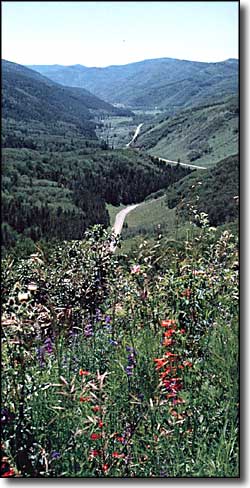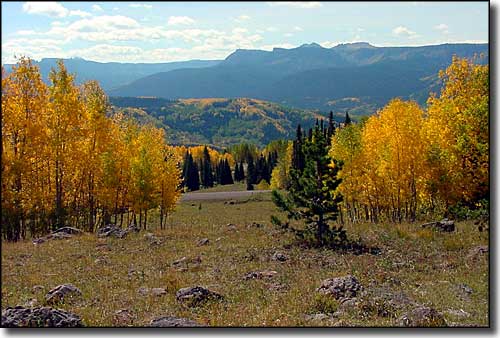
Flat Tops Trail Scenic Byway

Trappers Lake

This route passes through the White River Plateau Timberland Reserve, the second unit of what was the prototype of the National Forest system. The area's long history of preservation and multiple use land management makes for pristine scenery and excellent wildlife viewing opportunities. However, there are still active mines, ranches and timber producing projects around here. The "Cradle of Wilderness" (Trapper's Lake) is also found in this area. The Colorado Division of Wildlife claims the Meeker-area elk herd is the largest in the state and this area tends to be overrun with orange-clad folks in the fall.
About 40 miles of this 82-mile byway is unpaved. Most normal cars have no problem on the main route but the side roads can get very sloppy in wet times and 2WD vehicles can easily have a problem out here. The Byway gets between 2 and 10 feet of snow in the winter and most of it is not plowed. However, if there's enough snow on the ground, the route is great for snowmobiles and cross-country skiers. In the summertime, the local ranchers use the byway to move their livestock to and from summer pasture and, at times, there will be herds of livestock on the road, so be careful.
The elevation varies from 6,200 feet to more than 10,000 feet along the way. This means differing climate and vegetation zones between the valley floors and the mountains. Summer afternoon temperatures usually run from the low 70's to the low 90's while the nights can be anything from the 30's to the upper 50's. Summer thundershowers blow up quite often in the afternoons but they also usually pass through pretty quickly and leave fresher, cooler air in their wake.
The Utes used to spend their summers here where the vegetation was very lush and the fishing and hunting were excellent. Until a Government Indian Agent by the name of Nathan Meeker arrived in 1878. He saw the Indians as a threat to his future agricultural empire so he set out to civilize them by plowing up their lands and converting them into farmers. This insanity of his led to the killing of him and 10 other government employees (the Meeker Massacre). This outbreak of violence was just what the government needed to call out the troops and forcibly remove the Utes from this, their homeland, and confine them on reservations far away. This event was also the last major Indian uprising in Colorado.
With the Utes out of the way, the door was open for American settlers to safely come in and develop (and abuse) the rich natural resources of the area. The damage down to the land in that drive to make money caused the federal government to pass laws for setting aside "Forest Reserves" to try to mitigate the problem. The Flat Tops Trail and the White River Forest are part of the second Forest Reserve in the United States. This happened around the turn of the 19th century.
Then Teddy Roosevelt came here to hunt and discovered the level of resentment the local folks had toward the government "locking up" the land in the way the Forest Reserves did. This led to the Organic Act of 1897 which mandated that the federal government find a way to provide clean water, timber and opportunities for other commodity production for the benefit of the public from the renewable resources that the Forest is made up of. This led to the creation of the US Forest Service.
After years of effort, in 1919, Arthur H. Carhart finally got the government to stop all construction of roads and homes around Trapper's Lake. He felt that the lake was a wilderness resource that should be preserved "as is" for future generations. He was the true founder of the wilderness movement that ultimately led to the Wilderness Act of 1964 (that's why Trappers Lake is known as "the Cradle of Wilderness").
The Flat Tops themselves are the product of immense lava flows back in the mountain building times. The deep valleys and lake-dotted amphitheaters were created by glacial movements during the Ice Ages. When the Americans first entered this area, the place was thick with coniferous forests but human-caused forest fires in the 19th century opened up space for the aspens to come back and the fires activated the aspen seeds that had lain dormant for many years. This is how aspens returned to the alpine areas of Colorado.
In elevations above the aspens, there are thousands of dead but still standing "snags," Engelmann Spruce that were killed by a beetle epidemic in the 1940's. While these snags are great for the wildlife, they do fall over sometimes and can present significant danger to humans hiking and camping around here. Above 11,000 feet the landscape is covered with a fragile alpine tundra, in these areas you might want to stay on a trail and try not to do any more damage to the vegetation.
The Flat Tops Scenic Byway crosses the Routt National Forest and the White River National Forest and comes pretty close to the Flat Tops Wilderness. The whole length of the road, you will be presented with incredible photo opportunities so you'll want to be prepared.

Fall in the Flat Tops

Flat Tops Trail Scenic Byway area map
